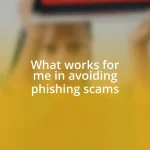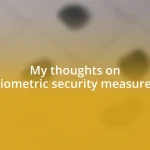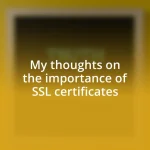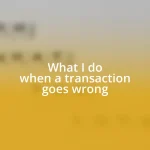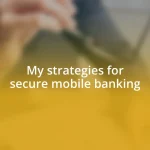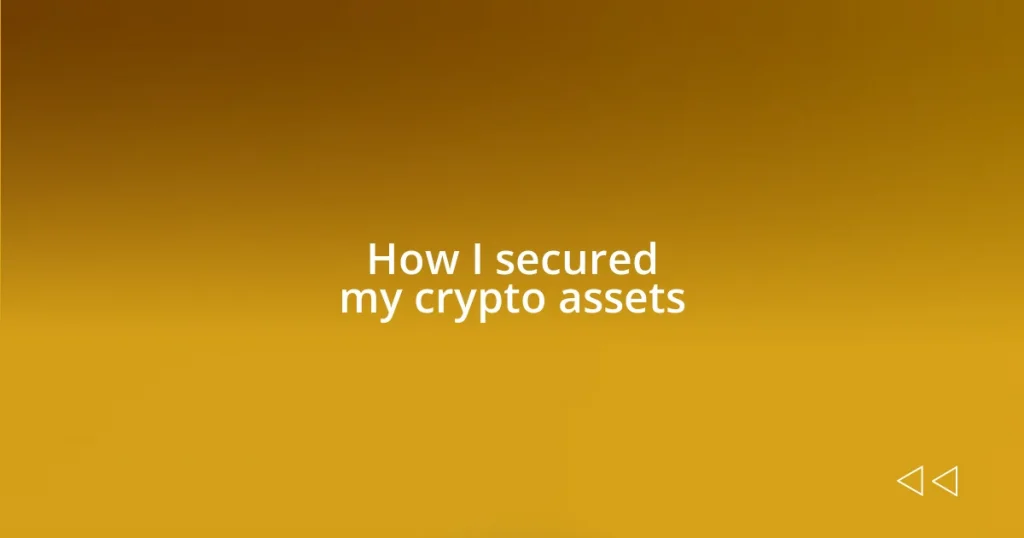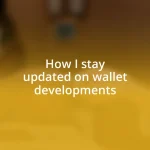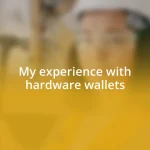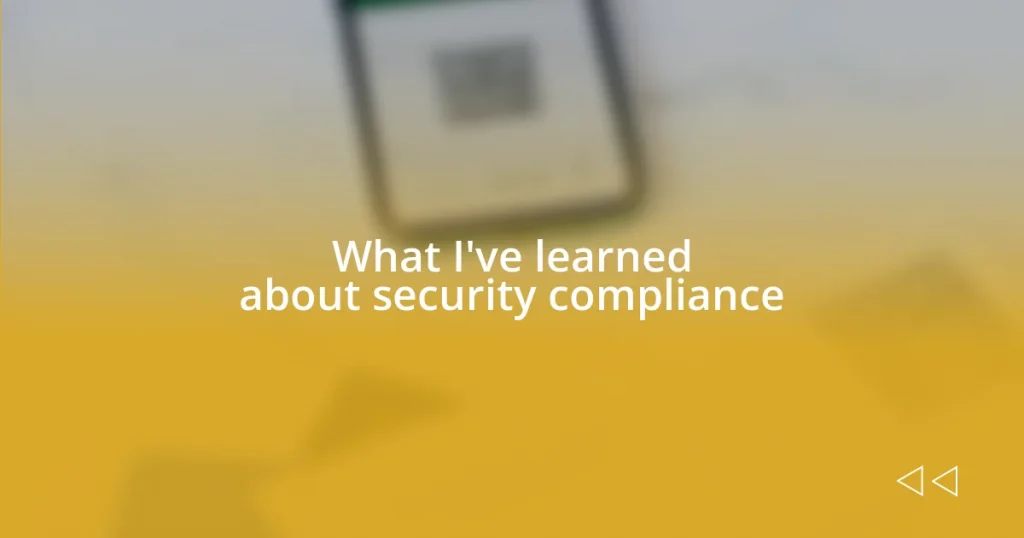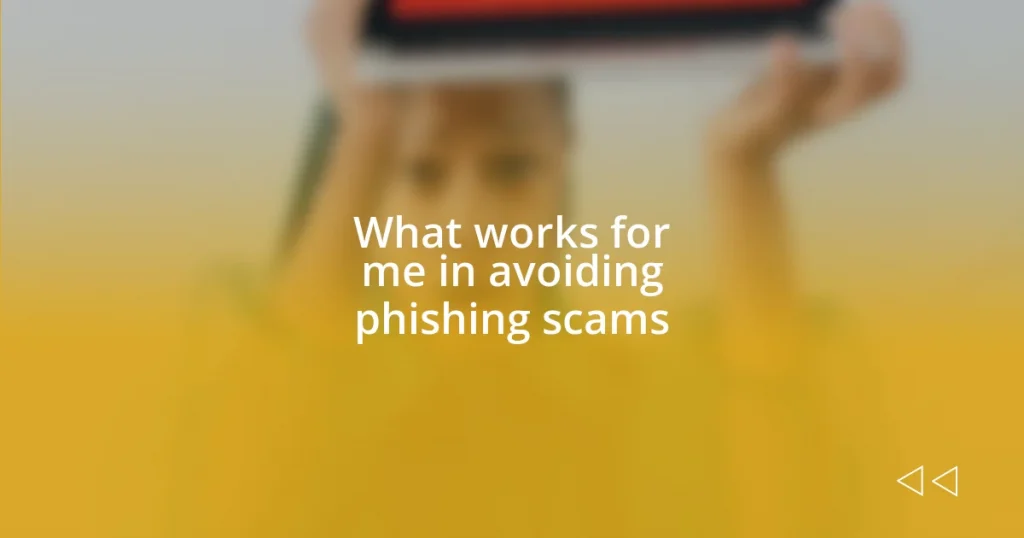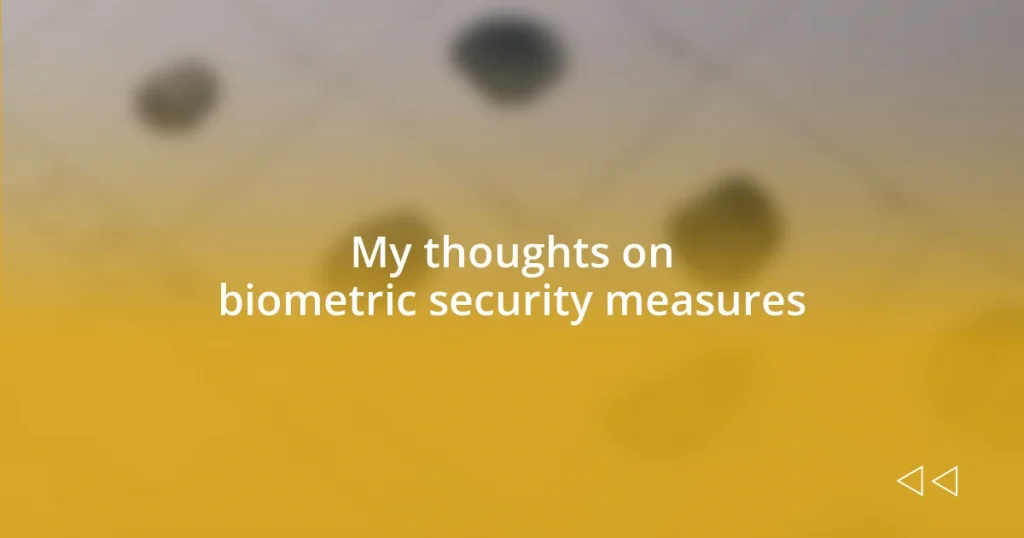Key takeaways:
- Understanding and securely managing private keys is fundamental to protecting crypto assets.
- Implementing strong password practices, including unique passwords and two-factor authentication, significantly enhances security.
- Regular security audits and staying informed about emerging threats help in maintaining robust safeguards for digital investments.

Understanding crypto asset security
When I first ventured into the world of cryptocurrencies, I was overwhelmed by the prospect of securing my digital assets. It’s fascinating—and a bit nerve-wracking—how many layers of security you need to consider. Have you ever worried that your hard-earned investments could just vanish overnight?
I remember the moment I realized the importance of understanding private keys. It’s almost like having the keys to your front door; without them, you can’t get in—or worse, someone else could. Keeping track of these keys became a ritual for me, cementing the fact that security isn’t just about tools but also about adopting habits that protect what’s important.
As I started exploring hardware wallets, I felt a sense of relief wash over me. The idea of having a physical device that stored my crypto assets offline felt reassuring. It was as if I had taken proactive steps towards ensuring my digital treasure was safe from potential threats. What’s your approach to safeguarding your crypto? Each choice we make can shape our confidence in navigating this volatile landscape.

Choosing the right wallet type
Choosing the right wallet type can feel like a daunting task, especially when I think back to my early days in crypto. I initially opted for a hot wallet, thinking it would be the most convenient option for my trading needs. However, I quickly learned that convenience often comes with trade-offs in security. Now, I weigh my options based on how frequently I plan to access my assets versus how much I’m willing to expose them to potential risks.
Here’s a quick breakdown of wallet types that I considered during my journey:
- Hot Wallets: These are connected to the internet and great for everyday transactions but come with higher security risks.
- Cold Wallets: Perfect for long-term storage, these wallets are offline, making them less vulnerable to hacking.
- Hardware Wallets: A physical device that stores your keys offline; I found using one to be both secure and user-friendly.
- Paper Wallets: A printed piece containing your keys; while secure, I felt a bit nervous about misplacing such an important document.
- Mobile Wallets: Convenient for on-the-go transactions, but I always ensure they have solid security features before using them.
By examining these wallet types through my own experiences, I realized the importance of aligning the choice with my own risk tolerance and usage habits. This process not only enhanced my security but also improved my confidence in managing my investments.

Implementing strong password practices
Implementing strong passwords has become an essential step in my journey of securing crypto assets. I recall sitting at my desk, typing out a password and realizing how easy it would be for someone to crack it. I promptly decided to make my passwords not just strong but unique for every platform. Using a combination of upper and lower case letters, numbers, and special characters, I crafted phrases that are meaningful yet difficult for others to guess. It was a mix of creativity and strategy—creating something that not only protects my assets but also sticks in my mind.
Over time, I’ve learned the value of password managers. Initially, I was skeptical, worried about putting all my passwords in one place. But when I tried one, I felt a sense of relief. It took the burden off remembering complex passwords for every single account. I remember the first time I generated a random password with a password manager; it was like watching a magician pull a rabbit out of a hat! Now, my passwords are not only strong, but I also don’t have to recall each one, which allows me to focus on the more enjoyable aspects of investing.
Reflecting on two-factor authentication (2FA), I can’t stress its importance enough. By simple adding an extra layer of security, I turned my login processes into a much safer ritual. There was a time I forgot to enable it and felt a wave of regret wash over me. Discovering that my favorite exchange offered 2FA made me jump at the opportunity—it felt like locking the door behind me after a trip outside. It’s become a non-negotiable part of my security practice.
| Password Practice | Details |
|---|---|
| Strong Password Creation | Use a mix of characters to create unique passwords for different platforms. |
| Utilizing Password Managers | Store and generate complex passwords securely, alleviating the need to remember them all. |
| Embracing Two-Factor Authentication | Add an extra layer of security to logins—essential for protecting your accounts. |
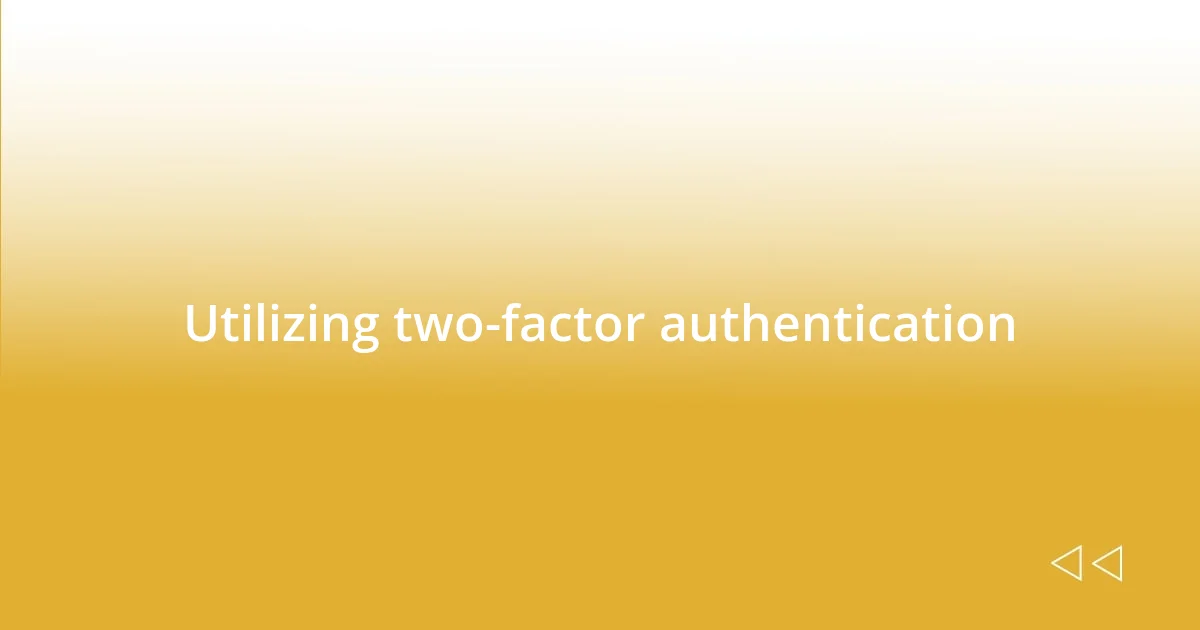
Utilizing two-factor authentication
When I first encountered two-factor authentication (2FA), I was a bit skeptical. I remember thinking, “Do I really need this extra step?” But after a close call with a phishing attempt, I quickly changed my mind. The peace of mind I gained from enabling 2FA was transformative; it felt like fortifying my digital castle with an impenetrable moat.
I particularly enjoy using authenticator apps, like Google Authenticator or Authy. They generate time-sensitive codes that are unique to each login attempt, making it incredibly tough for anyone else to gain access. I still recall the first time I used it. I felt this surge of empowerment knowing that even if someone got my password, they’d be stumped at the second hurdle. Isn’t it reassuring to think your assets are just a bit safer with that extra layer?
There’s also a huge convenience factor here. Once I had it set up, I found myself breezing through logins, feeling like I had harnessed a sophisticated tool. Sure, it takes a little bit of effort upfront, but seriously, who wouldn’t trade a few seconds for stronger security? Whenever I engage with my crypto accounts, 2FA acts as a comforting shield—an indelible part of my online experience.

Regularly updating wallet software
Maintaining up-to-date wallet software is crucial in my security journey. I remember one moment when I hesitated to update my wallet, thinking it couldn’t be that important. But after learning about a critical vulnerability that had been patched in a recent update, I realized how wrong I was. Ignoring those updates could have left my assets exposed, and that’s a risk I simply couldn’t take.
I’ve made it a habit to check for updates at least once a month. The process is usually quick, but the peace of mind that comes with it is invaluable. I often liken it to getting a routine check-up for my digital health. It may seem tedious, but just like with regular physical health check-ups, it’s a small effort that can prevent serious problems down the line. I also appreciate the new features that often come with updates, making my user experience smoother. Who wouldn’t want a wallet that works just a little better?
Moreover, I’ve learned to enable automatic updates whenever possible. This not only saves time but ensures that I’m always operating with the latest security measures without much thought. In today’s fast-paced world, I can do without the added stress of remembering to check for updates constantly. Thinking back on it, it’s like setting my coffee maker to brew automatically—less hassle, more security. Isn’t it comforting knowing that you’re consistently protected without extra effort?

Conducting regular security audits
Conducting regular security audits
I can’t stress enough how essential regular security audits have been for my peace of mind. Initially, I thought, “How complicated could this be?” But when I finally took the dive, evaluating my security practices revealed gaps I hadn’t even considered. During my first audit, I discovered outdated information on some of my accounts. It left me grateful for the nudge to be proactive; I wouldn’t have noticed otherwise.
Implementing a schedule for these audits has been a game changer. I typically set aside time every few months to review all my settings, from recovery options to access permissions. It’s like spring cleaning for my digital assets. Each audit provides a clear picture of my security landscape, reinforcing what’s working and what needs attention. Sometimes, I find myself asking, “What if a hacker targeted my account right now?” That question drives me to be thorough, as I believe there’s no such thing as being overly cautious when it comes to protecting my investments.
Reflecting on my recent audit, I was pleasantly surprised by how much I learned about using security tools effectively. It felt rewarding to strengthen my defenses, almost like leveling up in a game. I even started documenting my findings so I can track my progress over time. The key takeaway? Taking a little time to scrutinize your security can make a massive difference. Don’t you want to sleep soundly knowing you’ve done everything to protect your crypto assets?
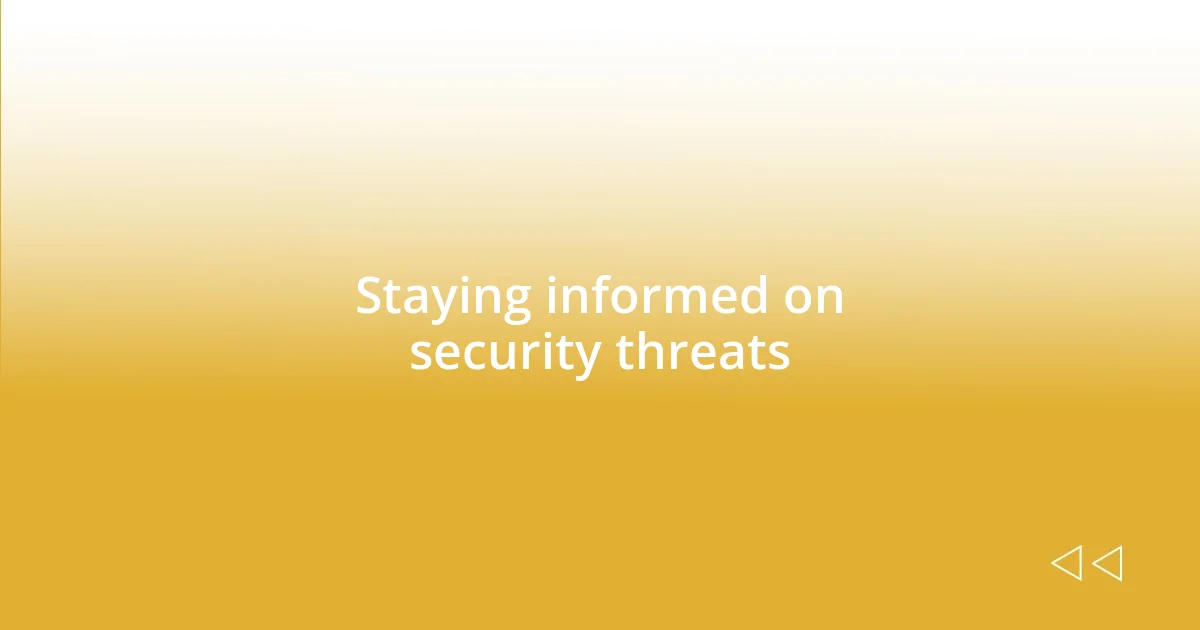
Staying informed on security threats
Staying informed on security threats is an ongoing commitment that has profoundly influenced my approach to safeguarding my crypto assets. I remember the anxiety I felt when I first heard about a phishing scheme that targeted crypto users. It shook me to my core and served as a wake-up call; I needed to be more vigilant. Since then, I’ve made it a point to stay updated by following reliable crypto news sources and engaging in online communities where security threats are discussed. It’s like being part of a watchful neighborhood watch — we’re all looking out for each other.
I also utilize social media to keep current with emerging threats. I follow hashtag alerts related to crypto scams and vulnerabilities. It’s remarkable how much information you can glean just by scrolling through your feed. I often find myself thinking, “If only I had known about this sooner!” Each new piece of information reminds me of the necessity to remain vigilant and share these insights with others. There’s a sense of camaraderie in knowing we’re all in this together, trying to navigate a space that can sometimes feel perilous.
Lastly, I’ve learned the importance of sharing experiences with fellow crypto enthusiasts. After hearing about a friend’s close call with a malware attack, I realized how valuable it is to discuss security tactics among peers. Sharing stories not only spreads awareness but also plants the seed for better practices. When was the last time you talked about security with someone? I usually feel that those conversations not only strengthen our defenses but also create a supportive network, which makes me feel more empowered in my crypto journey.

